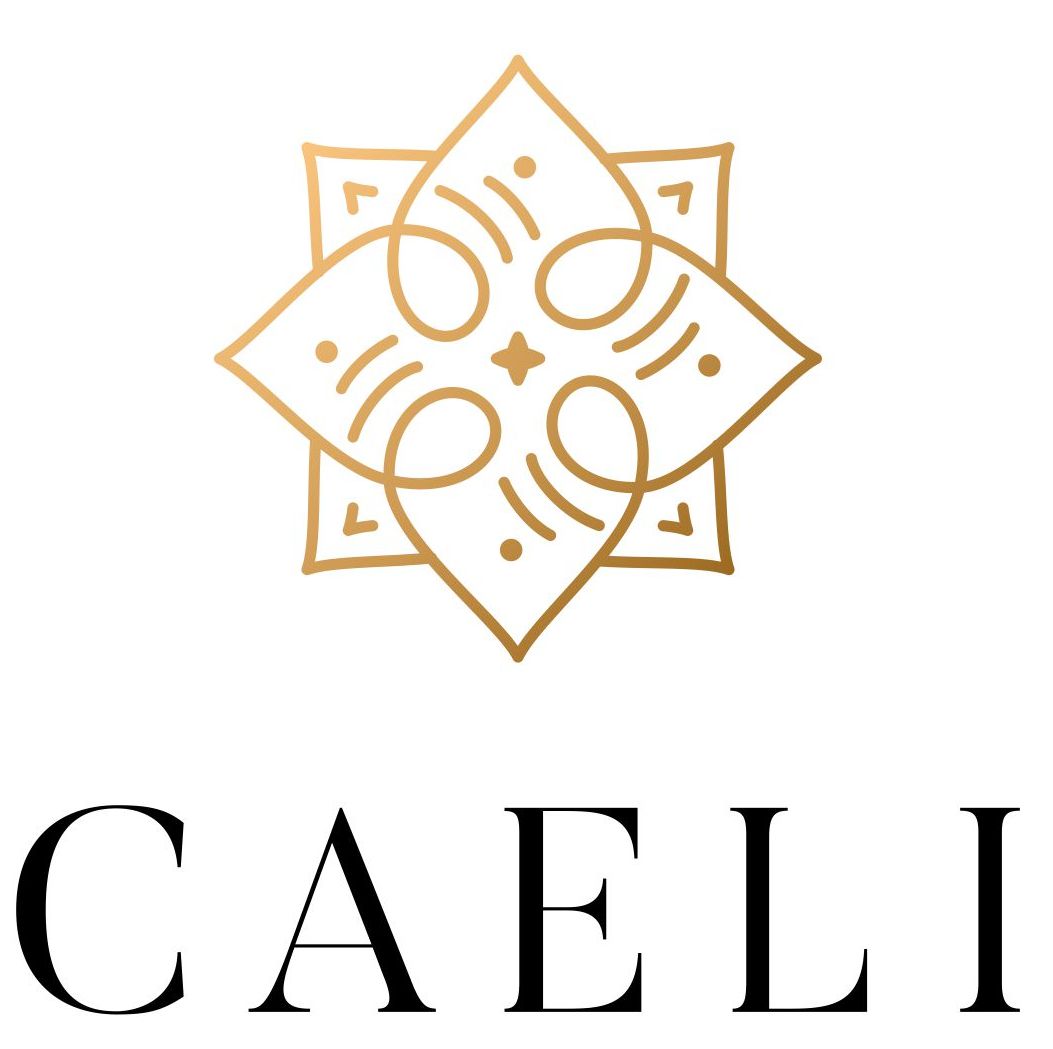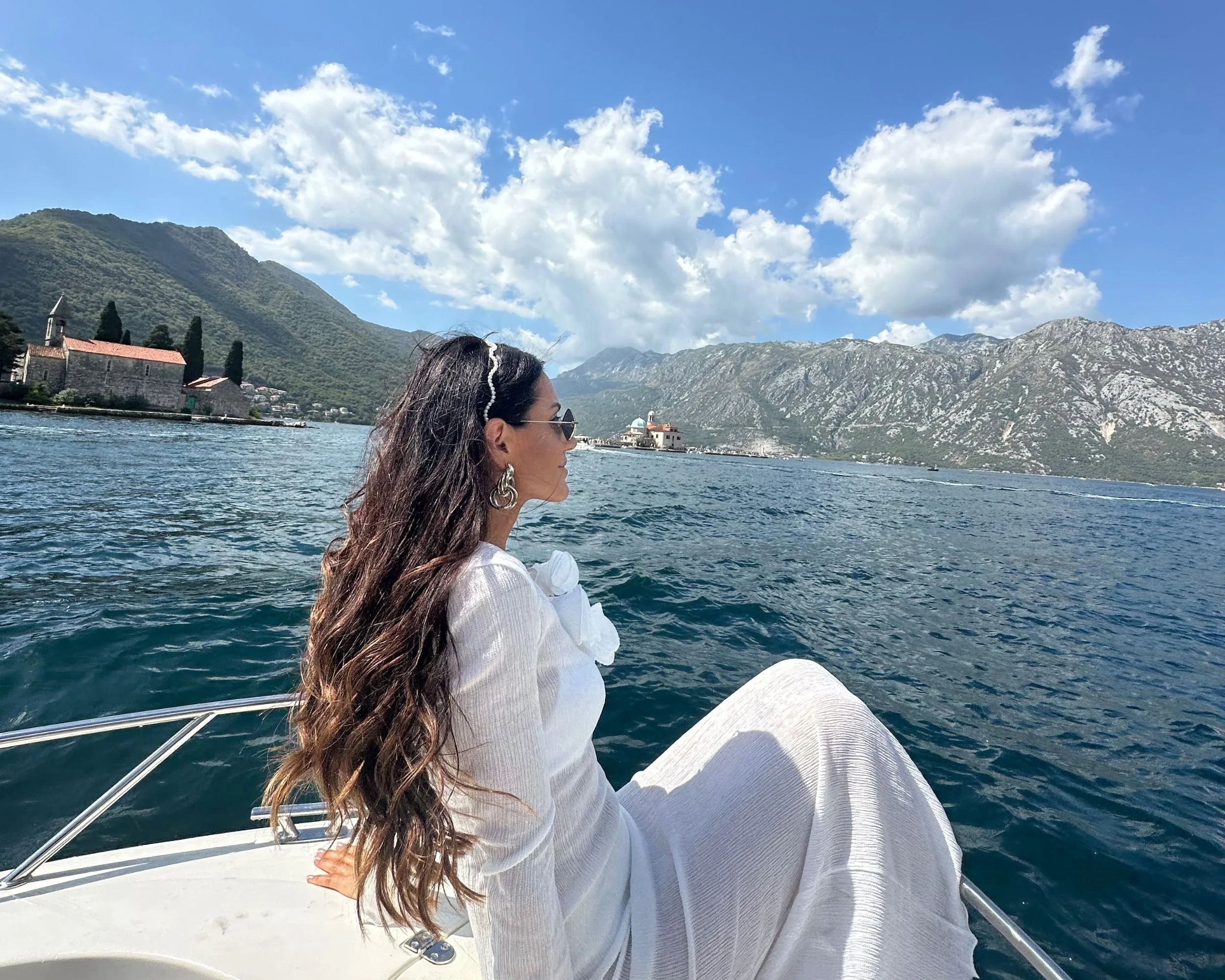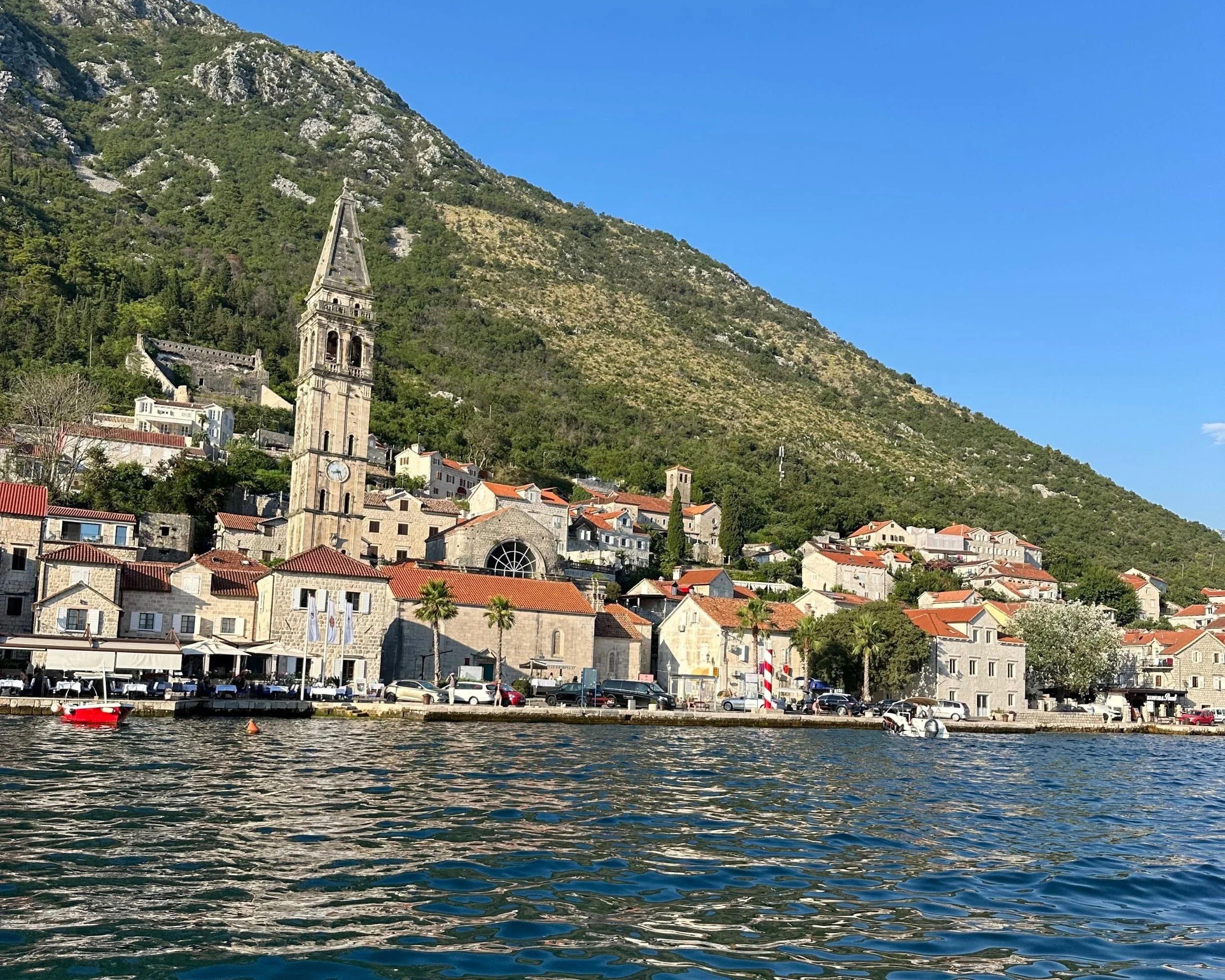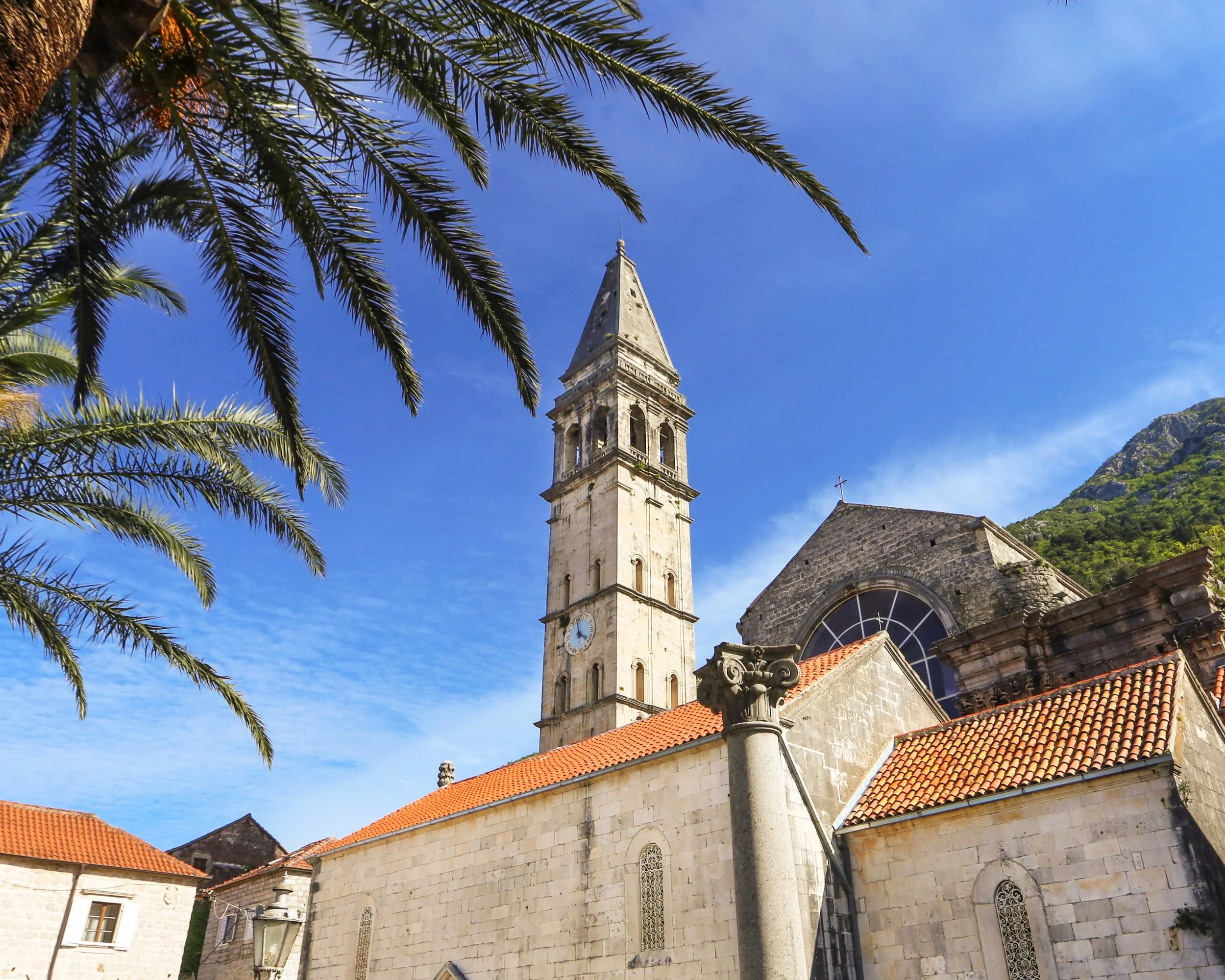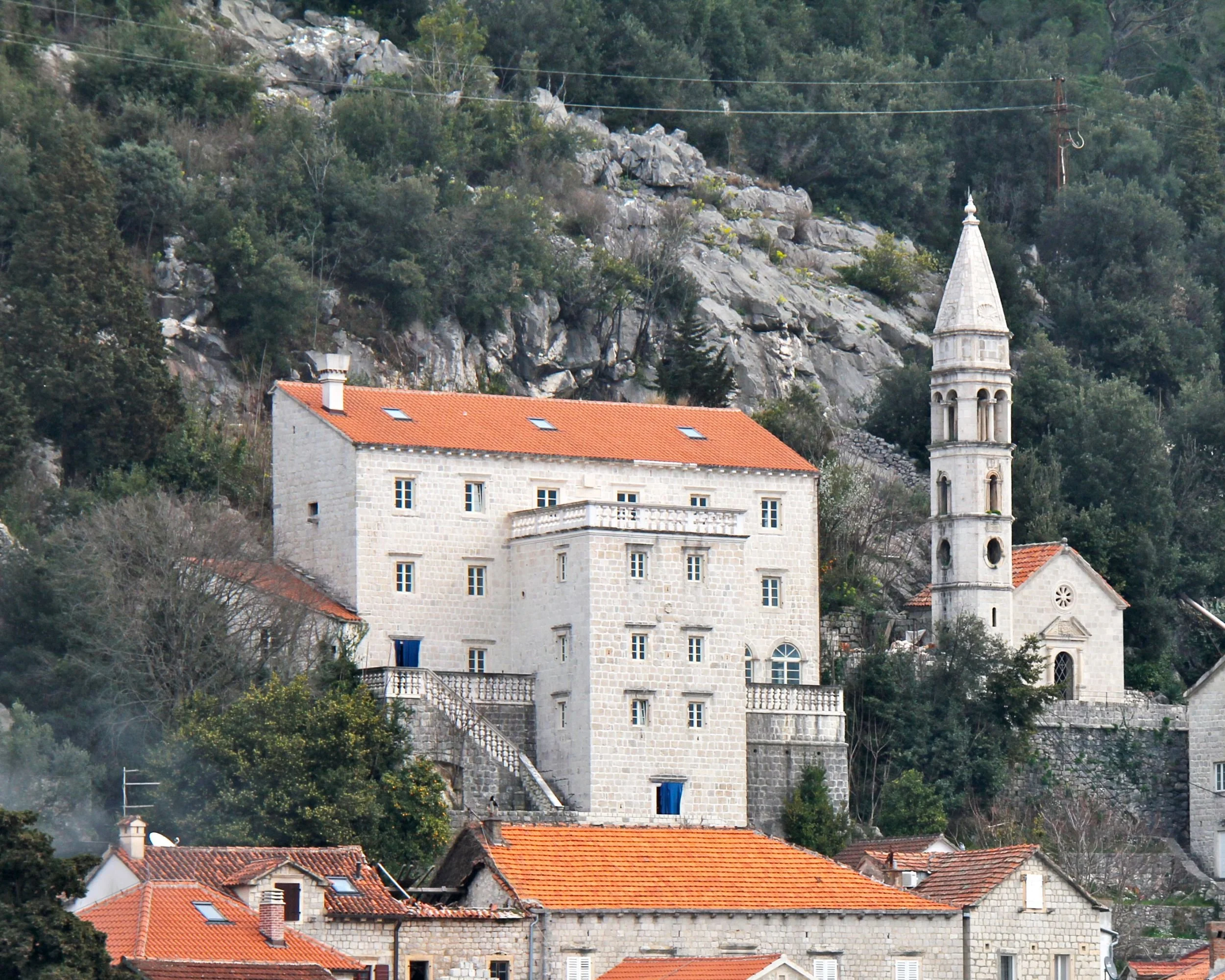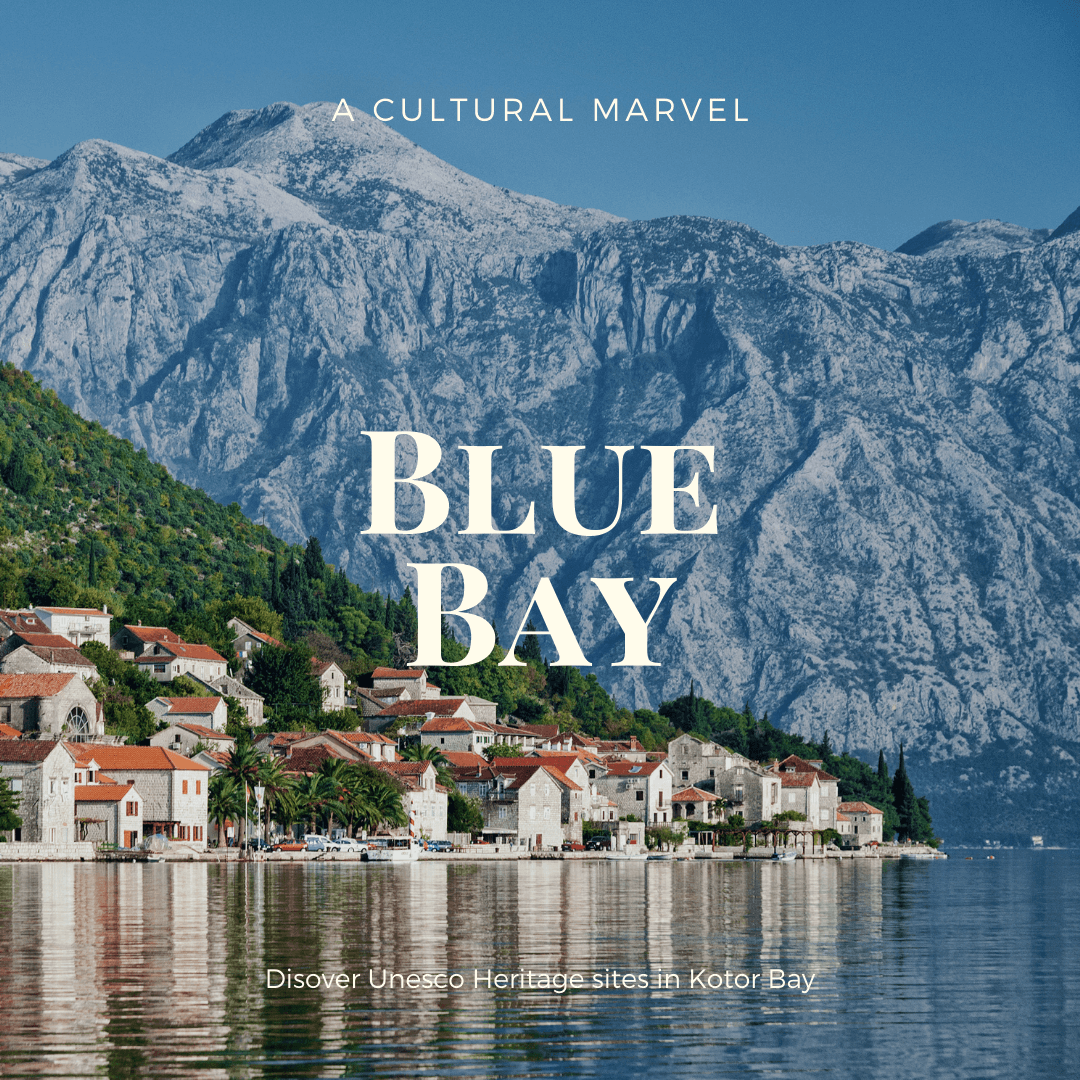Perast: Arguably the Most Beautiful Town in Montenegro’s Bay of Kotor
Enjoying coast of Perast on a private boat tour of Kotor Bay.
Just 12 kilometers from the UNESCO-listed town of Kotor lies Perast, one of Montenegro’s most historically rich and enchanting coastal villages. Nestled beneath St. Elijah Hill (Sveti Ilija), which rises to 873 meters above sea level, Perast sits on a cape dividing the Bay of Risan from the Bay of Kotor—two arms of the greater Boka Kotorska Bay, as Montenegrins like to call it. The town also overlooks the Verige Strait, the narrowest point in the bay, at only 300 meters between two shores.
With an average annual temperature of 18.3°C and 240 sunny days per year (about 2,500 hours of sunshine), Perast offers both a favorable climate and unparalleled scenery, making it a must-see stop for anyone traveling through Montenegro’s Adriatic coast.
“When the pearls of nature were sown, handfuls of them were cast on this soil.” – Lord Byron
Make sure you visit this little town when in Montenegro. The dramatic slopes of Lovcen mountain which rise over 1000 meters are a sight yoou will never forget. Read more about Lovcen National Park here.
Perast coastline from the boat
What Makes Perast, Montenegro So Special?
Perast is a small town with grand stories - a UNESCO heritage site. Its preserved baroque architecture, deep-rooted naval legacy, and two islets of mythical beauty make it one of the top destinations in the Bay of Kotor. Despite its tiny size, Perast contains:
19 churches (17 Catholic, 2 Orthodox)
16 palaces
9 defensive towers
A Walk Through the Town of Perast
walking the Main Street
Perast has just one main seaside street lined with stone buildings and centuries-old palaces, streching 2 km along the coast. Behind it, a network of stairways climbs the hillside. It’s a pedestrian-friendly town, ideal for walking and absorbing its timeless charm. If you are staying longer in Perast, make sure you also go the unbeaten path and walk to the top of the town, the views are spectacular.
Perast Central square with St. Nicholas church
The Church of St. Nicholas (Sveti Nikola)
Located on Perast’s main square, St. Nicholas Church is one of the most recognizable landmarks in the Bay of Kotor and a symbol of the town’s golden age. Originally built in 1616 on the foundations of a smaller 1564 church, the current structure reflects the town’s deep Catholic heritage and architectural ambition. In 1691, the church was significantly expanded in the Baroque style, and by 1713, its bell tower stood 55 meters high, housing what were then the largest bells in Europe. The bell tower alone cost an astonishing 50,000 ducats, highlighting the wealth and importance of Perast during its peak as a maritime and cultural hub.
The church’s interior is renowned for its frescoes by Tripo Kokolja, one of Montenegro’s most celebrated Baroque painters. His work can also be found in other regional churches, such as St. Anne's Church, affirming his lasting artistic legacy.
A new, larger church was initiated in 1740 directly behind the original structure, intended to replace it. However, construction was halted during the Napoleonic Wars, leaving only the apse and sacristies completed. Rather than demolishing the old church, the builders merged the unfinished extension with the existing one. As a result, St. Nicholas Church remains incomplete to this day, a striking contrast to its ambitious beginnings. With the Catholic population in the Bay of Kotor having declined significantly since the 18th century, the original vision of a grand cathedral may never be realized.
Visitors can explore the church’s treasury, which holds ornately embroidered liturgical vestments and relics of various saints. For a small fee (€2), climbing the impressive bell tower rewards visitors with panoramic views over Perast and the bay—an unmissable experience for those interested in history, architecture, or photography.
The Defensive Towers of Perast
Although Perast was never surrounded by defensive walls, it was well protected by nine defensive towers.
St. Cross Fortress: Perast’s Strategic Stronghold Over the Bay of Kotor
Perched above the historic town of Perast, the Fortress of St. Cross (Sv. Križ) played a vital role in the town’s defense system during the Venetian era. Built in 1570, nearly a century after the Ottoman Empire captured nearby Risan in 1482, the fortress helped defend the land border of the Venetian Republic and secure the entrance to the Bay of Kotor, especially the strategically important Verige Strait directly opposite Perast.
Unlike other fortified coastal towns, Perast was never surrounded by complete city walls. Instead, its protection relied on a network of nine defensive towers, with the Tower of the Holy Cross being the most significant. These fortifications were constructed in the 15th and 16th centuries, during the long rule of the Venetian Republic, which governed much of the Adriatic coast.
Over the centuries, the Fortress of St. Cross and surrounding ramparts were occupied by several foreign powers. After the fall of Venice, Napoleon’s troops took control in 1813, followed by the Austro-Hungarian Empire. Although many of the towers have fallen into ruin, remnants of these defensive structures are still visible today, high above the city—offering a glimpse into Perast’s military past and its critical role in protecting one of the Adriatic’s most coveted bays.
Perast, a UNESCO heritage town in Montenegro.
The History of Perast
The Venetian Golden Age
Perast reached its zenith in the 18th century, under the rule of the Republic of Venice. During this period:
The town boasted four operational shipyards
It maintained a fleet of approximately 100 ships
Its population peaked at 1,643 residents
This era saw the construction of its most beautiful buildings and public works.
After the Venice fall, Perast was ruled by Austro-Hungaria among others. You can read about Austro-Hungarian heritage here.
Maritime Tradition
Perast was a town of shipbuilders, sailors, and naval officers. Already by 1336, Perast had a functioning shipyard. By the end of the 1700s, it had over 80 merchant and war ships. Many of these vessels bore the name Our Lady of the Rock (Gospa od Škrpjela) in homage to the Virgin Mary, protector of sailors.
Famous Residents of Perast
Marko Martinović
In 1698, this esteemed sailor and educator trained 17 Russian naval cadets under orders from Peter the Great, laying the foundation of Russia’s future navy.
Among Perast’s many legendary seafarers, Captain Marko Martinović (1663–1716) stands out as one of the most respected and influential figures in the town's maritime history. Born and baptized in Perast by Archbishop Andrija Zmajević, Martinović dedicated his life to navigation, trade, and education. Unlike many of his peers, he was educated locally — at the Franciscan monastery of St. Anthony — before applying his knowledge aboard his ship, the Cavalier Vigilante.
His greatest legacy came in 1697, when the Venetian Senate selected him to train Russian nobles and boyars, personally sent by Peter the Great to learn the art of seafaring from the best. Martinović taught them how to read wind and navigation charts and led them on real voyages, including one from Venice to Perast. This historic moment is captured in a famous painting displayed in the Perast City Museum, depicting Martinović teaching his Russian students.
His home, known as “Nautika”, located next to the museum, was the first nautical school on the Balkans, and a plaque on the building commemorates its significance. His mentorship of Russian nobility marked the beginning of strong ties between Boka Kotorska and Imperial Russia.
Today, the main seaside promenade in Perast — stretching 1,300 meters — proudly bears the name Obala kapetana Marka Martinovića, and his bust stands in the town’s main square in front of St. Nicholas Church, a lasting tribute to the man who shaped Perast into a beacon of maritime excellence.
Matija Zmajević
A native of Perast, he went on to become an admiral of the Russian Baltic fleet, famously defeating the Swedish navy in 1721
One of Perast’s most prominent and influential families, the Zmajević family, left a lasting legacy that is still visible in the town's architecture, history, and culture. Originally from Njeguši and descended from the Draktić family, their name and coat of arms — featuring a dragon (“zmaj”) — reflect a proud and noble lineage. The family settled in Kotor in the 16th century and later in Perast in the 17th, where they built the grand Zmajević Palace in 1664, alongside their private church, Our Lady of the Rosary, and the only octagonal bell tower on the Balkans.
Admiral Matija Zmajević (1680–1735), Andrija’s nephew. A gifted naval commander, he became one of the leading figures in the Russian Imperial Navy, eventually founding the Caspian fleet. Despite being exiled from Perast after being implicated in the politically charged murder of Conte Vicko Bujović, Matija remained deeply connected to his homeland and supported it throughout his life. Although he died and was buried in Russia, his bust stands proudly in Perast, honoring his achievements.
Tripo Kokolja
Celebrated baroque painter, born in Perast, Kokolja was a visionary artist whose most celebrated work is the monumental interior decoration of the Church of Our Lady of the Rocks, a votive sanctuary on a man-made island just off the town’s coast. Commissioned by his patron, Archbishop Andrija Zmajević, Kokolja spent a decade (1684–1694) transforming the church with 68 oil paintings that include grand biblical scenes, saints, angels, floral still lifes, and the coat of arms of Perast. This cycle is among the most complex and unified baroque achievements in the region. Kokolja is also credited with introducing still life and landscape painting into Dalmatian art. Beyond his sacred work, he painted portraits, auto-portraits, and frescoes across Boka Kotorska, Korčula, and even Dubrovnik. Despite political unrest, particularly the murder of his close friend and patron Vicko Bujović, Kokolja’s artistic influence endured. He died in Korčula in 1713, but his spirit lives on in the richly painted walls of Perast, making the town a must-visit for lovers of art, history, and baroque splendor.
Andrija Zmajević
Respected bishop and influential cultural figure: The most notable figure from Zmajevic family was Archbishop Andrija Zmajević (1624–1694), an educated man who studied philosophy and theology in Rome, becoming Archbishop of Bar and Primate of Serbia in 1671. Although a Catholic cleric, he respected Orthodox traditions and the Slavic language, writing his most important work, Ljetopis crkovni, in both Cyrillic and Latin script. A patron of the arts and culture, he supported local talent like painter Tripo Kokolja and contributed significantly to the religious and cultural life of the region. His episcopal ring remains in the sanctuary of Our Lady of the Rocks, and his remains are buried in the family chapel in Perast.
Today, the Zmajević name is woven into the very fabric of Perast — from the monumental palace and chapel, to the island of Saint George, where their family crest still marks ancient graves, symbolizing that while their journeys took them far, their hearts remained in Perast.
Perast as an Autonomous Municipality
In 1580, the Venetian Republic awarded Perast autonomous municipal status, placing it under the administrative control of nearby Kotor but recognizing its strategic importance and seafaring legacy.
The Palaces of Perast
Among Perast’s 16 grand palaces, several stand out for their elegance and historical importance:
Bujovic Palace terrace
Bujović Palace
Located on the waterfront in the western part of Perast, Bujović Palace is one of the most stunning examples of Baroque-Renaissance architecture on the Adriatic coast, today a museum. This historic palace was built using hewn stone from the dismantled walls of Herceg Novi, reclaimed after its liberation from Ottoman rule in 1687. According to tradition, this act symbolized victory and renewal. Construction of the palace began in 1694, as indicated by three stone tablets on its façade, which also commemorate the heroism of Vicko Bujović, a local nobleman who played a key role in the campaign. The palace was financed by the Venetian Republic in gratitude for his service.
Vicko and his brother Ivan Bujović came from the noble house Casada Stojisić, a prominent family in Perast. The palace was designed by renowned Venetian architect Giovanni Battista Fontana, and it reflects a blend of Renaissance elegance and early Baroque richness. The arcaded ground-floor porch features pillars built using the bugnato technique, lending the structure a sense of fortified nobility. Above, five graceful balconies span three facades, showcasing harmonious symmetry and intricate stone ornamentation typical of the Baroque transition.
Zmajevic Palace, one of the most beautiful palaces in Perast.
Zmajević Palace
Located in the western part of Perast, in the area known as Prenčici, the Zmajević Palace is one of the most significant architectural and historical landmarks in the Bay of Kotor. Also known as “The Bishopric”, this imposing structure served as the residence of two prominent bishops—Andrija Zmajević and Vicko Zmajević—making it not only a noble family home but also a spiritual and cultural center in its time.
The palace, crowned with a distinctive octagonal bell tower and accompanied by a private family chapel dedicated to Our Lady of the Rosary, is widely considered the most visually striking and valuable architectural entity in Perast. Built on solid rock using locally sourced stone, Zmajević Palace blends seamlessly into the coastal landscape, with its symmetrical design and commanding presence over a natural rock cave. The palace wings are supported by thick stone walls, while a grand external staircase adds to its baroque elegance. Though it was built in multiple phases, its final design—completed during Bishop Andrija Zmajević’s era—displays the harmony and craftsmanship of a structure that appears to have been built all at once.
An inscription on the palace facade refers to the year 1664, marking the final phase of its construction and baroque transformation. The Zmajević family, originally part of the casada Perojević, proudly displayed their coat of arms: a winged dragon and star above two crossed leather straps, a traditional symbol of their lineage. Before this palace was erected, the family lived in a coastal house that long retained the original Zmajević crest.
Beyond its striking appearance, Zmajević Palace also housed one of the largest private libraries in Dalmatia, a testament to the family's scholarly pursuits and cultural importance in the region. Though the library no longer survives, its historical legacy and the intellectual prestige it brought to Perast remain.
Today, Zmajević Palace stands as a powerful symbol of Montenegro’s baroque heritage, Venetian architectural influence, and the noble traditions that once defined the town of Perast. It is a must-visit for anyone interested in historic architecture, religious history, or the legacy of noble families in the Bay of Kotor.
Smekja Palace - Iberostar 5 star hotel
Smekja Palace
Smekja Palace, the largest and most elegant palace in Perast, stands as a testament to the town's former maritime wealth and noble heritage. Located near the Church of St. Mark, this imposing stone structure overlooks the picturesque islands of Our Lady of the Rocks and St. George, two of Montenegro's most iconic landmarks. Built in two stages — the older section dating back to 1764, and the newer part completed in 1936 — the palace is made entirely of Korčula stone and reflects a blend of Renaissance simplicity and Baroque elegance, visible in its arched windows, shell-shaped motifs, and terrace balustrades adorned with rosettes.
The Smekja family, originally seafarers of the Čizmai Kazada clan, rose to prominence in the 18th century, particularly under Petar Smekja, who expanded their maritime trade across the Baltic and Venice. The emblem of the house features a hand holding a plant stalk—called “čičimak”—with stars, which signifies the family’s maritime heritage and noble standing. His successful voyages earned him the title of Count in 1748, and by 1779 the family was granted noble status in Kotor. The palace itself features an arched passage over the street, a distinctive element of coastal architecture, connecting its two sections. In 1936, a clothing factory named “Jadran Perast” operated within its walls, adding to its layered history.
Today, Smekja Palace is not only a stunning architectural landmark but also a symbol of Perast's golden era — when ships from this small coastal town sailed far and wide, and noble families like the Smekjas shaped the destiny of the Adriatic.
These opulent stone mansions showcase classic Venetian baroque architecture and reflect the wealth of Perast’s noble families.
The Islands of Perast
Our Lady of the Rocks (Gospa od Škrpjela)
This island is unique in the Adriatic Sea: it is man-made. Known originally in Venetian as "Madonna dello Scarpello," it was created in 1452 when two sailors found an icon of the Virgin Mary on a small rock (Škrpjel) in the sea.
Island Construction
Locals began to sink pirate ships and throw rocks to enlarge the island. Over the centuries, it expanded to an area of 3,030 square meters.
The original church was built in the 15th century. The current church was rebuilt after the 1667 earthquake.
Inside the Church
68 paintings by Tripo Kokolja adorn the walls and ceilings. A stunning tapestry, woven by Jacinita Kunić from 1803 to 1828, includes strands of her own hair. The Pomirbena dvorana, or "Reconciliation Room," is used for important meetings and ceremonies. The church holds over 2,500 silver votive tablets, left by sailors in thanks to the Virgin Mary for their safe returns from sea voyages.
The Fašinada Festival
Every July 22nd, locals celebrate the Fašinada, a procession where boats circle the island and throw stones into the sea—continuing the centuries-old tradition of expanding the island.
Two islands across Perast
St. George Island (Sveti Đorđe)
This natural island is home to the 12th-century Benedictine Monastery of St. George and served as a graveyard for Perast’s noble families. Shrouded in cypress trees, it has long been known as the Island of the Dead.
The "Cursed Island" Legend
According to local legend, the island was once cursed by the Pope after a crime occurred there, and Christians feared stepping onto it. It’s said the island was originally white but turned dark after Benedictine monks planted cypress trees—symbols of death and mortality.
The Tragic Tale of Ante Slovic and Katarina
During the French occupation of 1813, a garrison was stationed on St. George Island. One officer, Ante Slovic, fell in love with a local girl, Katarina. When ordered to fire a cannon at Fort St. Cross (Sv. Križ), he hesitated. But eventually, forced to obey, he accidentally struck Katarina’s home, killing her. Grief-stricken, Ante renounced military life, became a monk, and lived on the island until he died—found resting on Katarina’s grave, where he was later buried beside her.
Hiking Above Perast: The Austrian Fort Trail
For hiking enthusiasts, above the final houses of Perast lies an old Austrian military trail. This trail leads to a former Austrian fort, once the borderline between the Bay of Kotor and Montenegro. It’s about a 2-3 hour hike, offering panoramic views of the bay and a view into 19th-century military history.
Check the 8 best experiences you can have in Boka Bay here.
Why You Should Visit Perast
Despite its small size, Perast is one of the most historically and culturally rich destinations in Montenegro. From its baroque churches and grand palaces to the mystique of its islands and maritime legacy, it encapsulates the essence of the Bay of Kotor.
Whether you're interested in history, legend, architecture, or simply soaking in the Adriatic charm, Perast delivers an unforgettable experience. Don’t miss it when exploring the Montenegrin coast.
